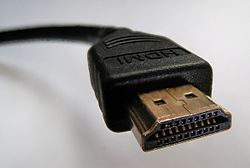
Back High-Definition Multimedia Interface Afrikaans واجهة متعددة الوسائط عالية الوضوح Arabic High-Definition Multimedia Interface AST HDMI Azerbaijani HDMI Byelorussian HDMI BE-X-OLD HDMI Bulgarian HDMI BS High-Definition Multimedia Interface Catalan ئێچ دی ئێم ئای CKB
 | |||
 Male HDMI "type A" connector | |||
| Type | Digital audio/video/data connector | ||
|---|---|---|---|
| Production history | |||
| Designer |
HDMI Forum (83 companies)[2]
| ||
| Designed | December 2002 | ||
| Manufacturer | HDMI Adopters (over 1,700 companies) | ||
| Superseded | DVI, VGA, SCART, RGB component, S-Video, composite video | ||
| General specifications | |||
| Width | 13.9 mm (type A), 10.42 mm (type C), 6.4 mm (type D) | ||
| Height | 4.45 mm (type A), 2.42 mm (type C), 2.8 mm (type D) | ||
| Hot pluggable | Yes | ||
| External | Yes | ||
| Audio signal | LPCM, Dolby Digital, DTS, DVD-Audio, Dolby Digital Plus, Dolby TrueHD, DTS-HD High Resolution Audio, DTS-HD Master Audio, MPCM, DSD, DST, Dolby Atmos, DTS:X | ||
| Video signal | Maximum resolution limited by available bandwidth | ||
| Pins | 19 | ||
| Data | |||
| Data signal | Yes | ||
| Bitrate | Up to 48 Gbit/s, as of HDMI 2.1b | ||
| Protocol | TMDS, Fixed Rate Link (FRL) | ||
| Pinout | |||
 | |||
| HDMI type A receptacle | |||
| Pin 1 | TMDS data2+ | ||
| Pin 2 | TMDS data2 shield | ||
| Pin 3 | TMDS data2− | ||
| Pin 4 | TMDS data1+ | ||
| Pin 5 | TMDS data1 shield | ||
| Pin 6 | TMDS data1− | ||
| Pin 7 | TMDS data0+ | ||
| Pin 8 | TMDS data0 shield | ||
| Pin 9 | TMDS data0− | ||
| Pin 10 | TMDS clock+ | ||
| Pin 11 | TMDS clock shield | ||
| Pin 12 | TMDS clock− | ||
| Pin 13 | Consumer Electronics Control (CEC) | ||
| Pin 14 |
| ||
| Pin 15 | SCL (I2C serial clock for DDC) | ||
| Pin 16 | SDA (I2C serial data for DDC) | ||
| Pin 17 | Ground (for DDC, CEC, ARC, and HEC) | ||
| Pin 18 | +5 V (up to 50 mA) | ||
| Pin 19 |
| ||
High-Definition Multimedia Interface (HDMI) is a proprietary audio/video interface for transmitting uncompressed video data and compressed or uncompressed digital audio data from a source device, such as a display controller, to a computer monitor, video projector, digital television, or digital audio device.[3] HDMI is a digital replacement for analog video standards.

HDMI implements the ANSI/CTA-861 standard, which defines video formats and waveforms, transport of compressed and uncompressed LPCM audio, auxiliary data, and implementations of the VESA EDID.[4][5]: p. III CEA-861 signals carried by HDMI are electrically compatible with the CEA-861 signals used by the Digital Visual Interface (DVI). No signal conversion is necessary, nor is there a loss of video quality when a DVI-to-HDMI adapter is used.[5]: §C The Consumer Electronics Control (CEC) capability allows HDMI devices to control each other when necessary and allows the user to operate multiple devices with one handheld remote control device.[5]: §6.3
Several versions of HDMI have been developed and deployed since the initial release of the technology, occasionally introducing new connectors with smaller form factors, but all versions still use the same basic pinout and are compatible with all connector types and cables. Other than improved audio and video capacity, performance, resolution and color spaces, newer versions have optional advanced features such as 3D, Ethernet data connection, and CEC extensions.
Production of consumer HDMI products started in late 2003.[6] In Europe, either DVI-HDCP or HDMI is included in the HD ready in-store labeling specification for TV sets for HDTV, formulated by EICTA with SES Astra in 2005. HDMI began to appear on consumer HDTVs in 2004 and camcorders and digital still cameras in 2006.[7][8] As of January 2021[update], nearly 10 billion HDMI devices have been sold.[9]
- ^ "HDMI Adopters and Founders". HDMI. Archived from the original on August 1, 2012. Retrieved April 14, 2015.
- ^ "Members". HDMI Forum. Retrieved March 16, 2017.
- ^ "HDMI FAQ". HDMI.org. Archived from the original on February 22, 2018. Retrieved July 9, 2007.
- ^ CEA-861-D, A DTV Profile for Uncompressed High Speed Digital Interfaces, §1 Scope
- ^ a b c High-Definition Multimedia Interface Specification 1.3a (PDF), HDMI Licensing, LLC, November 10, 2006, archived from the original (PDF) on March 5, 2016, retrieved April 1, 2016 – via Microprocessor.org
- ^ "The First HDMI Consumer Electronics Products Debut at Cedia 2003" (Press release). Indianapolis, IN: HDMI.org. September 5, 2003. Archived from the original on April 23, 2018. Retrieved August 17, 2022.
- ^ Samsung (February 24, 2006). "Samsung Camera Releases New High-Performance Digimax L85 Featuring World's First High Definition Multimedia Interface". dpreview.com. Retrieved July 1, 2008.
- ^ "Canon's new feature-packed HV20 HD camcorder expands high definition camcorder capabilities and choices for consumers". Canon. January 31, 2007. Archived from the original on March 3, 2019. Retrieved July 1, 2008.
- ^ Cite error: The named reference
ces2021prwas invoked but never defined (see the help page).
© MMXXIII Rich X Search. We shall prevail. All rights reserved. Rich X Search